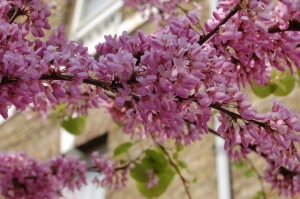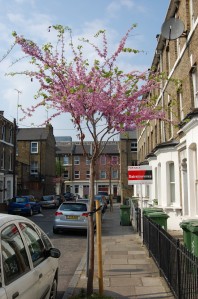Position: Full sun but will tolerate partial shade
Soil: Moist, well drained
Flowering period: Mid spring
Eventual Height: 10m
Eventual Spread: 10m
Hardiness: 5a, 5b, 6a, 6b, 7a, 7b, 8a, 8b, 9a, 9b
Family: Fabaceae
Cercis siliquastrum is a small deciduous tree with a spreading sometimes multi-stemmed habit. It has inversely heart to kidney shaped, glaucous, blue green leaves with notched tips that turn yellow in autumn. It bears clusters of 3-6, pink, magenta or occasionally white flowers on year old wood. These appear before and with the leaves and often appear directly on the branches of the tree. The tree produces long flat pea like seed pods that hang vertically.
Cercis siliquastrum, commonly known as the Judas tree, is native to southern Europe and western Asia. It is mainly cultivated for ornamental use and was first described by Linnaeus in 1753.
The etymological root of the binomial name Cercis was a name given to the plant by the ancient Greek philosopher Theophrastus. It was Linnaeus who gave it the species name siliquastrum, which is derived from the Latin siliqua meaning, “pod”.
The landscape architect may find Cercis siliquastrum useful as a small tree for adding colour to restricted locations. Due to its high canopy, tolerance of poor, compacted soils and urban pollution this tree is well suited as a street tree.
Cercis siliquastrum will tolerate poor, compacted soils and urban pollution.
Ecologically, Cercis siliquastrum will attract pollinating insects such as bees that will feed on its nectar.
The Royal Horticultural Society have given the variety Cercis siliquastrum ‘Bodnant’ their prestigious Award of Garden Merit 2012.
Cercis siliquastrum requires little care, dead or damaged material should be removed at the end of winter







Leave a comment